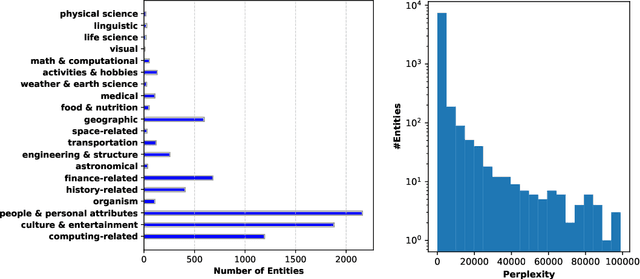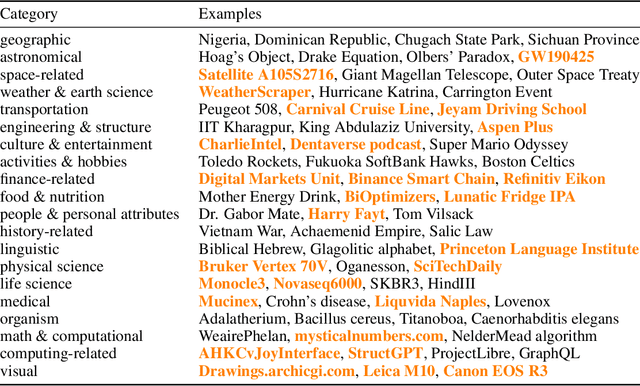Yuntian Deng
WildVis: Open Source Visualizer for Million-Scale Chat Logs in the Wild
Sep 05, 2024Abstract:The increasing availability of real-world conversation data offers exciting opportunities for researchers to study user-chatbot interactions. However, the sheer volume of this data makes manually examining individual conversations impractical. To overcome this challenge, we introduce WildVis, an interactive tool that enables fast, versatile, and large-scale conversation analysis. WildVis provides search and visualization capabilities in the text and embedding spaces based on a list of criteria. To manage million-scale datasets, we implemented optimizations including search index construction, embedding precomputation and compression, and caching to ensure responsive user interactions within seconds. We demonstrate WildVis's utility through three case studies: facilitating chatbot misuse research, visualizing and comparing topic distributions across datasets, and characterizing user-specific conversation patterns. WildVis is open-source and designed to be extendable, supporting additional datasets and customized search and visualization functionalities.
WildHallucinations: Evaluating Long-form Factuality in LLMs with Real-World Entity Queries
Jul 24, 2024



Abstract:While hallucinations of large language models (LLMs) prevail as a major challenge, existing evaluation benchmarks on factuality do not cover the diverse domains of knowledge that the real-world users of LLMs seek information about. To bridge this gap, we introduce WildHallucinations, a benchmark that evaluates factuality. It does so by prompting LLMs to generate information about entities mined from user-chatbot conversations in the wild. These generations are then automatically fact-checked against a systematically curated knowledge source collected from web search. Notably, half of these real-world entities do not have associated Wikipedia pages. We evaluate 118,785 generations from 15 LLMs on 7,919 entities. We find that LLMs consistently hallucinate more on entities without Wikipedia pages and exhibit varying hallucination rates across different domains. Finally, given the same base models, adding a retrieval component only slightly reduces hallucinations but does not eliminate hallucinations.
Magpie: Alignment Data Synthesis from Scratch by Prompting Aligned LLMs with Nothing
Jun 12, 2024Abstract:High-quality instruction data is critical for aligning large language models (LLMs). Although some models, such as Llama-3-Instruct, have open weights, their alignment data remain private, which hinders the democratization of AI. High human labor costs and a limited, predefined scope for prompting prevent existing open-source data creation methods from scaling effectively, potentially limiting the diversity and quality of public alignment datasets. Is it possible to synthesize high-quality instruction data at scale by extracting it directly from an aligned LLM? We present a self-synthesis method for generating large-scale alignment data named Magpie. Our key observation is that aligned LLMs like Llama-3-Instruct can generate a user query when we input only the left-side templates up to the position reserved for user messages, thanks to their auto-regressive nature. We use this method to prompt Llama-3-Instruct and generate 4 million instructions along with their corresponding responses. We perform a comprehensive analysis of the extracted data and select 300K high-quality instances. To compare Magpie data with other public instruction datasets, we fine-tune Llama-3-8B-Base with each dataset and evaluate the performance of the fine-tuned models. Our results indicate that in some tasks, models fine-tuned with Magpie perform comparably to the official Llama-3-8B-Instruct, despite the latter being enhanced with 10 million data points through supervised fine-tuning (SFT) and subsequent feedback learning. We also show that using Magpie solely for SFT can surpass the performance of previous public datasets utilized for both SFT and preference optimization, such as direct preference optimization with UltraFeedback. This advantage is evident on alignment benchmarks such as AlpacaEval, ArenaHard, and WildBench.
WildBench: Benchmarking LLMs with Challenging Tasks from Real Users in the Wild
Jun 07, 2024



Abstract:We introduce WildBench, an automated evaluation framework designed to benchmark large language models (LLMs) using challenging, real-world user queries. WildBench consists of 1,024 tasks carefully selected from over one million human-chatbot conversation logs. For automated evaluation with WildBench, we have developed two metrics, WB-Reward and WB-Score, which are computable using advanced LLMs such as GPT-4-turbo. WildBench evaluation uses task-specific checklists to evaluate model outputs systematically and provides structured explanations that justify the scores and comparisons, resulting in more reliable and interpretable automatic judgments. WB-Reward employs fine-grained pairwise comparisons between model responses, generating five potential outcomes: much better, slightly better, slightly worse, much worse, or a tie. Unlike previous evaluations that employed a single baseline model, we selected three baseline models at varying performance levels to ensure a comprehensive pairwise evaluation. Additionally, we propose a simple method to mitigate length bias, by converting outcomes of ``slightly better/worse'' to ``tie'' if the winner response exceeds the loser one by more than $K$ characters. WB-Score evaluates the quality of model outputs individually, making it a fast and cost-efficient evaluation metric. WildBench results demonstrate a strong correlation with the human-voted Elo ratings from Chatbot Arena on hard tasks. Specifically, WB-Reward achieves a Pearson correlation of 0.98 with top-ranking models. Additionally, WB-Score reaches 0.95, surpassing both ArenaHard's 0.91 and AlpacaEval2.0's 0.89 for length-controlled win rates, as well as the 0.87 for regular win rates.
MixEval: Deriving Wisdom of the Crowd from LLM Benchmark Mixtures
Jun 03, 2024



Abstract:Evaluating large language models (LLMs) is challenging. Traditional ground-truth-based benchmarks fail to capture the comprehensiveness and nuance of real-world queries, while LLM-as-judge benchmarks suffer from grading biases and limited query quantity. Both of them may also become contaminated over time. User-facing evaluation, such as Chatbot Arena, provides reliable signals but is costly and slow. In this work, we propose MixEval, a new paradigm for establishing efficient, gold-standard LLM evaluation by strategically mixing off-the-shelf benchmarks. It bridges (1) comprehensive and well-distributed real-world user queries and (2) efficient and fairly-graded ground-truth-based benchmarks, by matching queries mined from the web with similar queries from existing benchmarks. Based on MixEval, we further build MixEval-Hard, which offers more room for model improvement. Our benchmarks' advantages lie in (1) a 0.96 model ranking correlation with Chatbot Arena arising from the highly impartial query distribution and grading mechanism, (2) fast, cheap, and reproducible execution (6% of the time and cost of MMLU), and (3) dynamic evaluation enabled by the rapid and stable data update pipeline. We provide extensive meta-evaluation and analysis for our and existing LLM benchmarks to deepen the community's understanding of LLM evaluation and guide future research directions.
From Explicit CoT to Implicit CoT: Learning to Internalize CoT Step by Step
May 23, 2024Abstract:When leveraging language models for reasoning tasks, generating explicit chain-of-thought (CoT) steps often proves essential for achieving high accuracy in final outputs. In this paper, we investigate if models can be taught to internalize these CoT steps. To this end, we propose a simple yet effective method for internalizing CoT steps: starting with a model trained for explicit CoT reasoning, we gradually remove the intermediate steps and finetune the model. This process allows the model to internalize the intermediate reasoning steps, thus simplifying the reasoning process while maintaining high performance. Our approach enables a GPT-2 Small model to solve 9-by-9 multiplication with up to 99% accuracy, whereas standard training cannot solve beyond 4-by-4 multiplication. Furthermore, our method proves effective on larger language models, such as Mistral 7B, achieving over 50% accuracy on GSM8K without producing any intermediate steps.
WildChat: 1M ChatGPT Interaction Logs in the Wild
May 02, 2024Abstract:Chatbots such as GPT-4 and ChatGPT are now serving millions of users. Despite their widespread use, there remains a lack of public datasets showcasing how these tools are used by a population of users in practice. To bridge this gap, we offered free access to ChatGPT for online users in exchange for their affirmative, consensual opt-in to anonymously collect their chat transcripts and request headers. From this, we compiled WildChat, a corpus of 1 million user-ChatGPT conversations, which consists of over 2.5 million interaction turns. We compare WildChat with other popular user-chatbot interaction datasets, and find that our dataset offers the most diverse user prompts, contains the largest number of languages, and presents the richest variety of potentially toxic use-cases for researchers to study. In addition to timestamped chat transcripts, we enrich the dataset with demographic data, including state, country, and hashed IP addresses, alongside request headers. This augmentation allows for more detailed analysis of user behaviors across different geographical regions and temporal dimensions. Finally, because it captures a broad range of use cases, we demonstrate the dataset's potential utility in fine-tuning instruction-following models. WildChat is released at https://wildchat.allen.ai under AI2 ImpACT Licenses.
Implicit Chain of Thought Reasoning via Knowledge Distillation
Nov 02, 2023Abstract:To augment language models with the ability to reason, researchers usually prompt or finetune them to produce chain of thought reasoning steps before producing the final answer. However, although people use natural language to reason effectively, it may be that LMs could reason more effectively with some intermediate computation that is not in natural language. In this work, we explore an alternative reasoning approach: instead of explicitly producing the chain of thought reasoning steps, we use the language model's internal hidden states to perform implicit reasoning. The implicit reasoning steps are distilled from a teacher model trained on explicit chain-of-thought reasoning, and instead of doing reasoning "horizontally" by producing intermediate words one-by-one, we distill it such that the reasoning happens "vertically" among the hidden states in different layers. We conduct experiments on a multi-digit multiplication task and a grade school math problem dataset and find that this approach enables solving tasks previously not solvable without explicit chain-of-thought, at a speed comparable to no chain-of-thought.
Tree Prompting: Efficient Task Adaptation without Fine-Tuning
Oct 21, 2023Abstract:Prompting language models (LMs) is the main interface for applying them to new tasks. However, for smaller LMs, prompting provides low accuracy compared to gradient-based finetuning. Tree Prompting is an approach to prompting which builds a decision tree of prompts, linking multiple LM calls together to solve a task. At inference time, each call to the LM is determined by efficiently routing the outcome of the previous call using the tree. Experiments on classification datasets show that Tree Prompting improves accuracy over competing methods and is competitive with fine-tuning. We also show that variants of Tree Prompting allow inspection of a model's decision-making process.
DeepSpeed4Science Initiative: Enabling Large-Scale Scientific Discovery through Sophisticated AI System Technologies
Oct 11, 2023



Abstract:In the upcoming decade, deep learning may revolutionize the natural sciences, enhancing our capacity to model and predict natural occurrences. This could herald a new era of scientific exploration, bringing significant advancements across sectors from drug development to renewable energy. To answer this call, we present DeepSpeed4Science initiative (deepspeed4science.ai) which aims to build unique capabilities through AI system technology innovations to help domain experts to unlock today's biggest science mysteries. By leveraging DeepSpeed's current technology pillars (training, inference and compression) as base technology enablers, DeepSpeed4Science will create a new set of AI system technologies tailored for accelerating scientific discoveries by addressing their unique complexity beyond the common technical approaches used for accelerating generic large language models (LLMs). In this paper, we showcase the early progress we made with DeepSpeed4Science in addressing two of the critical system challenges in structural biology research.
 Add to Chrome
Add to Chrome Add to Firefox
Add to Firefox Add to Edge
Add to Edge